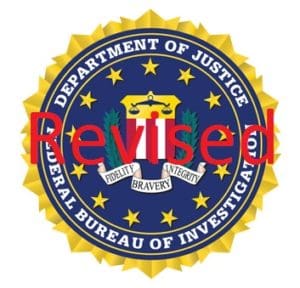 In my last post in the “Shoot Like the Pros” series, I covered the old FBI Qualification course of fire that every agent had to complete annually with an 85% or better score. It was a decent test of skills at various distances and even included a couple of situations where the agent needed to reload and get back into the fight. The problem is that it did not represent the kind of gunfights that FBI agents actually saw. Study after study has shown that most gunfights happen up close. It is rare to have a situation where an agent needs to fire his/her pistol at 25 yards. Instead, they need to be able to deploy and use their gun in close quarters, so a new standard was developed and implemented in 2013 . . .
In my last post in the “Shoot Like the Pros” series, I covered the old FBI Qualification course of fire that every agent had to complete annually with an 85% or better score. It was a decent test of skills at various distances and even included a couple of situations where the agent needed to reload and get back into the fight. The problem is that it did not represent the kind of gunfights that FBI agents actually saw. Study after study has shown that most gunfights happen up close. It is rare to have a situation where an agent needs to fire his/her pistol at 25 yards. Instead, they need to be able to deploy and use their gun in close quarters, so a new standard was developed and implemented in 2013 . . .
The target used for the new FBI Qualification course of fire is the QIT-99. This is modified version of the old “Q” target and has the bottom part of the bottle lopped off. It certainly provides a bit more challenge than the old target did.
Scoring: Shooters receive 1 point for every round that lands inside the Q bottle. Shots that break the outline of the bottle count. The course of fire is 60 rounds and agents must shoot 80% (48 hits) or better to qualify. Instructors need 90% (54 hits). This incidentally is a lower passing grade for agents than what was required on the old standard. There is no disqualification or penalty for hitting outside the bottle or for missing the target entirely. One new twist is that for all stages, the agent must draw from concealment.
Stage 1: 12 rounds, 3 yards , three strings, two of 3 seconds apiece and one of 8 seconds
For all stages, shooters start with gun holstered in concealment (under jacket, etc), hands at sides. At the beep, draw and fire three rounds strong side hand only in 3 seconds. Repeat this string of fire a second time. Finally, draw and and fire three rounds strong hand only, pass the gun to the support hand and fire three rounds support hand only. Complete the entire exercise in 8 seconds.
All subsequent stages are shot two handed.
Stage 2: 12 rounds, 5 yards, four strings of 3 rounds in 3 seconds each
At the beep, draw and fire three rounds in three seconds. Holster and repeat this drill three more times to make a total of 12 rounds. Reload your pistol as necessary between strings to ensure that you have enough ammo to complete each string. This stage does not test reload speed, so that should not be done on the clock.
Stage 3: 16 rounds, 7 yards, two strings of 4 rounds in 4 seconds each followed by a string of 8 rounds in 8 seconds
At the beep, draw and fire 4 rounds in 4 seconds. Repeat this string once more for a total of 8 rounds. Next, set up the gun so that there is one round in the chamber and the magazine is loaded with three rounds. Have a spare magazine with at least four rounds loaded. Draw and fire four rounds which should take your gun to slide lock. Reload (don’t forget that the replacement magazine needs to be drawn from concealment as well) and fire four more rounds. Total allowed time is 8 seconds.
Up to this point, the emphasis has been on being Quick Draw McGraw. As long as you can clear your holster in a reasonable amount of time, you should have no real problem nailing these first three stages. Frankly, at some point, Stage 2 in particular seems like a waste of ammo. If you can draw and shoot in 3 seconds at least twice, do you really need to demonstrate it twice more? Especially since you’ll be shooting for speed again during Stage 3 even further back. I would probably also eliminate the 4 rounds in 4 seconds part of Stage 3 and just have the candidates do the four rounds – reload – 4 rounds drill twice.
Stage 4: 10 rounds, 15 yards, two strings of 3 rounds in 6 seconds each followed by a string of 4 rounds in 8 seconds
At the beep, draw and fire 3 rounds in 6 seconds. Repeat this string once more for a total of 6 rounds. Finally, draw and fire 4 rounds in 8 seconds.
Stage 5: 10 rounds, 25 yards, two strings of 5 rounds in 15 seconds each
Equipment Needs: a barricade tall enough to stand behind.
Start beside the barricade. On the beep, move behind the barricade, draw and fire three rounds from behind the barricade. Kneel and fire two more rounds from behind the barricade. Complete the entire string in 15 seconds. Repeat this string a second time for a total of 10 rounds.
In my opinion, this is the only stage that presents any real challenge. Both times I ran this drill, it was only during Stage 5 that I missed the target at all. What is disappointing is that you could miss every single shot at 25 yards and presuming you hit with the rest of your rounds, you would still garner a passing score. Heck, you could even have two more misses and still make the 80% cutoff.
I didn’t have any of the QIT-99 targets on hand, but did figure out that I could convert a standard Q target to QIT by drawing a line cutting off the bottom fifth of the target. As long as my rounds stayed above the line, they were good.
On my second run through (above), I managed to score 96%, but I’m still annoyed that I missed the silhouette twice. Those could both have hit an innocent bystander. Both misses happened at 25 yards, so I know what I need to work on. One small piece of advice would be to shoot the 25 yard stage first. Once you get 50+ rounds on paper from the earlier stages, it gets a bit hard to tell if you missed the target completely or sent a round through an existing hole. If it seems my round count comes up short at 3 yards, I’m pretty confident I didn’t pull a round off the target. At 25 yards, I could very well have missed the target completely.
Once nice thing about this new standard (versus the old one) is that a slightly modified version of it can be done even at a square range (provided they’ll let you draw from a holster). There is no moving into position in this new standard nor is there a requirement to shoot from the prone position. The requirement for drawing from concealment for each string also adds an element of difficulty.
I’m not sure how happy I am with the significant reduction of movement in the new standard. With the exception of Stage 5 where you need to duck behind cover before firing, all of the other stages are shot standing stock still. As we’ve discussed time and again, one of the best techniques for surviving a gunfight is to be a moving target (or even better a target behind hard cover). Secondly, the emphasis in this version seems to be on rapid draw and engagement. How often are FBI agents getting into quick draw contests with perps? From the design of this standard, it would seem to suggest a lot. Third, there is only one string in one stage where the agent needs to work a reload. The old standard had two stages requiring a reload. Fourth, there is no provision for malfunction clearing. Granted, the FBI uses Glock pistols and we all know that Glocks never have malfunctions, but there’s always a chance an agent might someday have to use a pistol that is not a Glock and since we also know that every other manufacturer’s pistols have frequent malfunctions, you’d think it might be a good idea to test this.
The other thing that concerns me is that both this standard and the old one treated every hit within the lines of the bottle as equally good. Furthermore, as long as your break the line, the hit counts. We know from experience and evidence that marginal hits are not nearly as effective as solid center mass ones. Furthermore, the fact that no penalties are assessed for missing the target completely is just wrong. A miss on the silhouette in qualification translates to a round that misses the target in real life and ends up somewhere else – possibly in an innocent bystander. Police or Citizen, you are (or should be) responsible for every round that leaves your gun and qualifications like this don’t enforce that dictum.
To contrast the FBI’s standards, I’m in the process of preparing to take the Sig Sauer Master Pistol Instructor Class. To certify, I’ll be required to shoot Sig Sauer’s pistol qualification drill at a higher level of proficiency than was required when I took the Semiautomatic Pistol Instructor course. I’ve been asked not to publish the standard and I’ll honor that request, but I will tell you that Sig’s criteria are a good bit more stringent than the FBI’s. The Sig target has two valid hit zones – an eight inch circle center mass and a four inch one in the face. Shots that fall outside of those hit zones don’t count. Shots that touch the line on the hit zone don’t count. A shot needs to be cleanly in one of the hit zones to count. On top of this, even one shot that falls outside of the silhouette (or misses the target completely) is an automatic disqualification and it doesn’t matter how well you shot the rest of the course of fire – it won’t count.
In the end, I see the FBI qualification course as better than nothing and in some ways better than it was before. Depending on your gun handling skills, it may be tougher than it used to be, but I feel that it either omits or significantly reduces some important training elements.
Give it a shot and see if you have what it takes to be an FBI agent under the new standard.

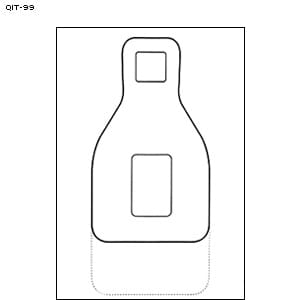
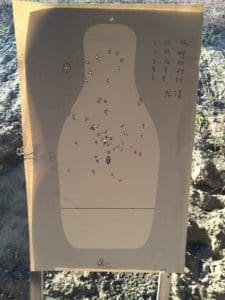

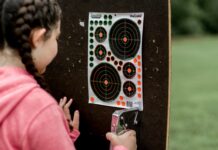
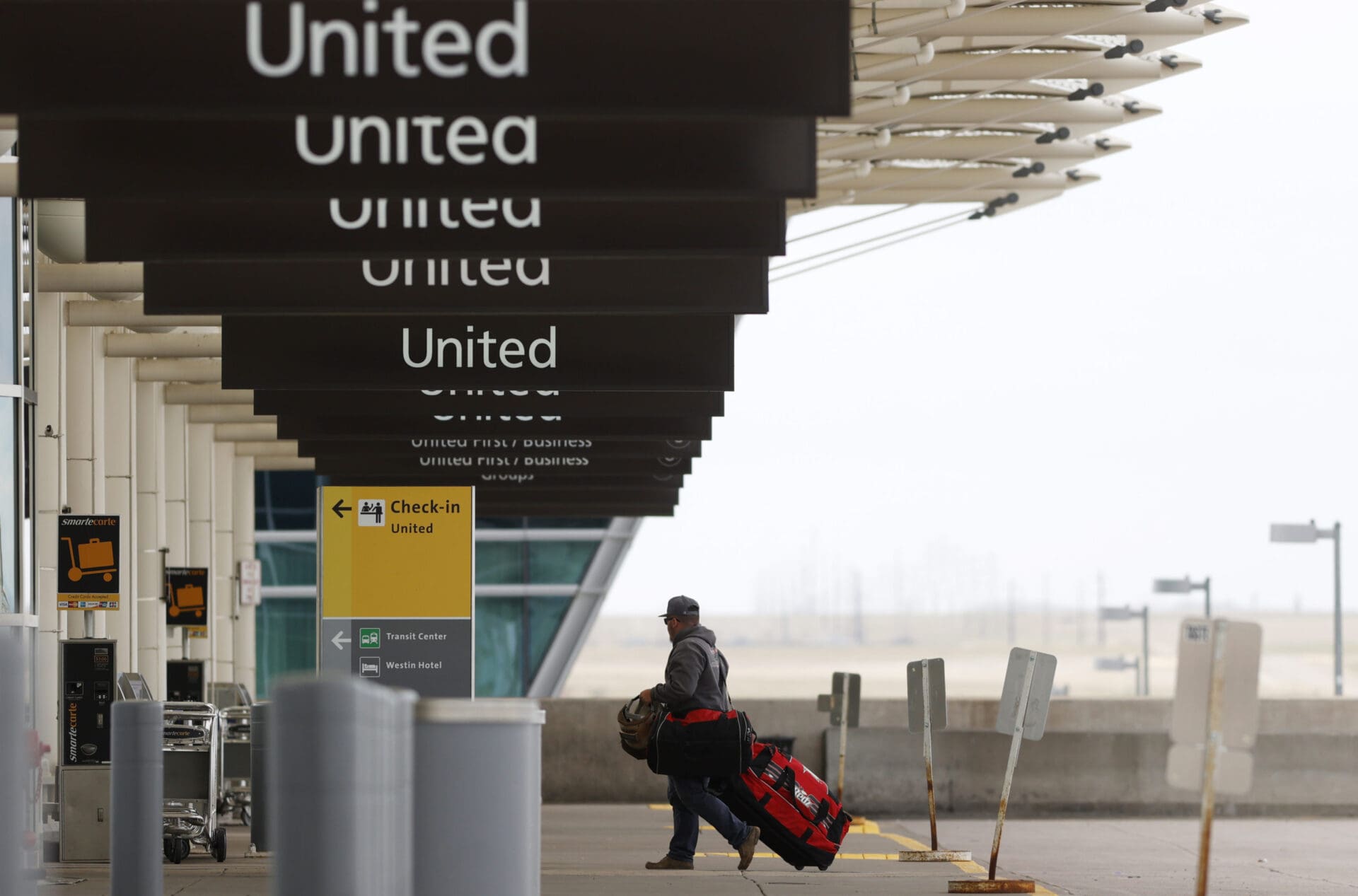
Always looking for new drills. I’ll give it a try.
Great write-up, liked the analysis, too.
I share your concern over the lack of required movement.
Not so worried about the edge-of-the-bottle hits, though. Hits in those areas will be far closer to center than edge hits on the old Tom Ridge badguy or full-size B-27 target (even outside-edge-of-8-ring hits on the B-27, I believe). In shortening the bottle, they made sure scored hits will probably stay in the lung zone.
Lets see the nypd qual
You start with the broad side of a barn…
… for aiming and count the hits on the other one?
Which you’re facing as you stand inside the barn…
make sure you put in the 40lb trigger kit too. It would be nice to have a apples to apples.
Why would anyone shoot at the head of that target unless to hotdog. Seems like that is really just a miss. A12x12 target would be better IMO.I like a 12″ piece of 2×6 myself.
Some organizations require you to make a certain amount of head shots to qualify. It is probably to simulate the difficulty of shooting under stress.
Body Armor.
Starting in the 90’s when armed encounters with determined assailants donning body armor became more prevalent (do you remember the North Hollywood shootout?), competent LE agencies across the US became aware that training exclusively to shoot center mass meant that under stress in a real firefight the LEO will react exactly as trained and exclusively shoot for center mass. Taking head shots on qualification targets is not a cowboy option for gifted marksman to show off, they most often are incorporated in close range drills at 3-5yds as directed by the range officer usually in the sequence of 2 to the body 1 to the head. Since the purpose of deadly force with a firearm is to stop the threat, if after two shots center mass the threat has not been stopped and seems unaffected, a head shot at close range is an effective means to stop an assailant wearing body armor. Other training further incorporates shots to the femoral region to break down support structure which deprives an assailant wearing body armor the ability to stand, walk, and advance in an armed encounter. Unfortunately too many LE agencies across the country are lacking when it comes to competent defensive firearms training and you can bet that few agencies in liberal strongholds have administrators who would dare allow such training and politically incorrect qualification courses.
And a Big California AMEN to that!
I can’t help but notice the new “PC” targets that look more like a bowling pin than a person. The old FBI targets were very clearly the silhouette of a man. Even the NRA Range will not allow any kind of realistic targets now. A few weeks ago, was doing Bill Drills using paper plates and on one I drew a smiley face just for fun. One of the range officers said that was not allowed.
Instead of drawing a smiley face, shoot a smiley face like Riggs did in “Lethal Weapon.” It’s harder than you think and lots of fun. And it won’t violate any doofy range rules.
Haha, I do that a lot. Of course, I watched Lethal Weapon about 100 times when I was younger. (Along with Die Hard.)
Perfect ! I did it as well when I shot my multi-state CCW course, the first 50 rnds carved out a 5″ circle so I used the last ten to cut a near perfect smiley face 2 eyes a nose & seven for the grin & the inst. watching me said the same thing (You’re just showing off now.)
Do they allow targets like the “bowling pin”? It may not be realistic, but neither is a smiley face. And everyone knows what that pin shape implies. Don’t they?
Yeah, they allow the bowling pin targets and everyone knows what it means, it’s just another dumb PC thing that takes some of the fun out of an activity. I remember shooting at Osama bin Laden targets years ago. Now that was more like it!
Lol I remember those XD
Makes sense to me that bureau agents have to shoot at least as well as CHP holders in my state.
This is very similar to my annual qualifier. Our is broken down into the short course, 10 yards and less, and the long course at 15 and 25 yards. Our passing score is 75% on each section.
These qualifications are by no means a marksmanship qualification. It’s a basic competency test that an average shooter can pass with just a few hundred rounds of practice a year. There are very little movement, all targets are static, and the timed strings give more than enough time for anyone to complete the shots.
The 25 yard shots are always a bitch. 25 yards is the limit of most modern duty guns. Factor 25 yards into a stressful situation where there are non threats and movement and you get a shot that you really should take.
Someone above mentioned the NYPD course, I’ll get it – I have a friend who works for the NYPD.
I agree that I think they need a new target. This one is too easy given the ranges they are shooting.. The Sig target you described is similar to the ones I shot for my “you get to be issued a handgun if you go to the Green Zone” qual although hits outside the circle still count as long as they are on silhouette. I still do qualification shoots with my carry guns as modified by range rules.
I can see where if you believe that you are going engage at really close range movement has been eliminated. Time and distance calculation will show you aren’t going to lower your chances of getting hit mucht unless were moving to contact already. The FBI probably thinks that the surprise gunfight is the more stressing case and if you can pass this test then you are ready for anything.
Unlike the old qual I am pretty sure I can pass this one.
I am always looking for new drills, and I very much like this series. But, I have to say after thinking about it, shooting like the “pros” e.g. the PD might be uh, low expectations. I want to shoot better than the pros, especially the NYPD which seems to have a pretty bleak record. The FBI has shot – what, maybe 200 people in 20 years (http://www.nytimes.com/2013/06/19/us/in-150-shootings-the-fbi-deemed-agents-faultless.html?pagewanted=all&_r=0)? Not a big sample.
It appears to be a decent qual course. Like most firearms training with LEO agencies, it’s a comprimise of time, training budget, ammo budget, etc.
As I’ve tried to make clear from my recent comments on these threads, you have to bear in mind that this is only the qualification course and that agents do lots of other shooting before/in addition to qualifying. That said …
I do think the course from 25 yds. is misguided–it requires the shooter to shoot too fast. You shouldn’t even really be thinking about shooting a handgun from 25 yds. unless that’s all you have with you, and in any case you need to be concentrating on your sights–which takes time. As the writer pointed out, the rest of the course is pretty easy. I do think an agent should be required to attain a respectable degree of proficiency from 25 yds. using sights, and that does take some practice. I can tell you that shooting the previous PQC I basically didn’t use my sights from ten yds. in, and at 15 yds. I was pretty much shooting over the sights for qualification–there’s no reason to do anything else given the size of the target because time becomes a bigger consideration than strict accuracy.
Another factor to keep in mind is that most agents are located in major cities and, being investigators first and foremost, have relatively little use for their weapons. But you never know. You never know when you might have to venture into rural territory, even suburban, and at that point distances like 25 yds. might not be so much out of the question. Not common, perhaps, but you should be training for every foreseeable eventuality.
FWIW, I suspect this new course is a bit of an AA course: make sure everyone passes, and we have our specialty teams to handle foreseeable situations where we need really good shooters. I suppose it’s a defensible training strategy, since the FBI’s primary mission is investigation–there are plenty of good shooters who can’t investigate their way out of a paper bag. Nevertheless, I think there’s a better balance.
Looks like a pretty simple course of fire on the close in targets. The 25 yard shots would be a little harder though.
FBI SA’s don’t do much shooting in their work duties. They GPS X’s car, collect all his email, record his phone calls, convert his friends into CI’s, track down his angry ex-wife or ex-girlfriend for intel, and plant people as close as they can to his operation. Then they indict him, force a plea or go to trial, send him to prison, and confiscate his money, house, boat, and so forth.
Not much shooting involved. Why overdo it? They always have some SA volunteers who want to take SWAT training, HRT stuff, shoot more on their own time. “Let those guys do the shooting!”
You’re delusional if you actually believe a FBI SA should not train to survive a deadly encounter. One of the few times in the Bureau’s history when mistakes were admitted was after the 1886 Miami shootout when two piece of $#it soon to be dead bank robbers killed two Agents and wounded five more. After that fiasco the FBI was forced to confront the truth that their approach and choice of weapons in defensive firearms training was woefully inadequate and that determined criminals aren’t always impressed when an Agent announces “FBI” and don’t always give up their gun and surrender just because an Agent’s gun is pointed in their direction.
Roping down is right. The FBI isn’t getting into the situations where a shooting is most likely to occur (domestic disputes, traffic stops, burglaries). Most of what the G men are investigating is a paper trail that leads to white collar crimes. When they do make arrests of dangerous subjects, they go in heavy with the local FBI office swat team and reinforcements from local LE.
1886?! YEE HAW! I think you might mean the shootout at OK corral, not Miami
http://www.youtube.com/watch?v=3pE4XI1dNWk
http://www.thegunzone.com/11april86.html
http://www.firearmstactical.com/briefs7.htm
1886 was obviously a typo, evidently you never heard about the FBI shootout in Miami in NINETEEN HUNDRED EIGHTY SIX, so I here’s a few links you might find informative
What you say is true for all LEOs. Very few ever have to use their weapon in the line of duty. That is probably why police firearms proficiency is so poor. They have other things on their training to do list that they need on an everyday basis. The cops/SAs who take it seriously do what we every day concealed carriers do. Practice on their own.
tdiinva, don’t know your source of info, but I’m afraid you’re misinformed. The FBI and most of the other large Federal LE Agencies get A LOT of advanced firearms training at taxpayers expense as do many State Police Agencies. The LE Agencies that get the least are small agencies with limited resources and larger agencies in deficit spending liberal strongholds like Chicago and Detroit.
I know all federal LEOs and Military Police get a lot of firearms training. I was speaking to the question about the adequacy of the new FBI qualification and why LEOs in general to put a lot of stress on firearms training. Additionally, training must be reinforced with practice. All LEOs have to do that on their own. I always know when some federal agency is going to have qualification because the range I go to if filled with Federal LEOs running drills in preparation for it.
Mr Barret:
Could you analyse and provide your opinion on the pistol qualification course used by the US Border Patrol? It was also used by Inspectors of US Immigration Service before getting absorbed by US Customs in 2003 and together they became US Customs and Border Protection. US Border patrol is not part of USCBP but DHS as they remained separate as before the DHS monster came into being and kept their own PQC which consists of 72 rounds, 360 points and distances involving 1.5, 3, 7, 15 and 25 yards with turning targets and time limits. US Customs had a revolver course of 30 rounds distances of 3, 7 and 15 yards but they use H&K P2000 semiautomatics now which they load with only 6 rounds instead of 12 to shoot the course. I am retired now, but I used to shoot an average of 340 points (around 94%) on a good day with a Beretta 96 in 40 S&W. It is one of the most demanding qualification courses in the Federal Government and those who read this forum can benefit from the familiarization of this pistol course. It is described in the USBP’s web site.
Comments are closed.